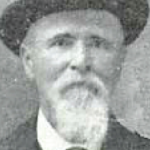
The Confederate War Department denied Gen. N. B. Forrest’s request to retain former infantry soldiers absent from their commands. Robert S. Henry wrote: “Forrest proceeded vigorously” to enforce the order sending these men back to the Army of Tennessee.
On Sunday, May 22 “Forrest ordered both divisions of his command to hold dress parade on foot, at which time designated men…were taken from ten regiments… arrested and forwarded under guard.”
Several of these men had served in infantry companies raised in Tipton County. Colonel James Neely described the incident purge:
“The Brigade was ordered to the field for Review and suddenly surrounded by another brigade with loaded guns (without my having been consulted) & certain infantry officers passed down the lines calling out the names of persons claimed as deserters from their commands. Privates and officers were seized in arrest, their horses (and arms and equipment) taken and ordered to be turned over to the Division quartermaster & they guarded off to Gen. (Joseph) Johnston’s army as deserters. Many of these men …had formerly belonged to infantry regiments raised in West Tennessee having volunteered for 12 months, had served out their terms with credit, had been furloughed for sickness & wounds received & permitted to go to their respective homes. In the meantime while they were at home on furlough in West Tenn. their respective regiments had been reorganized in the spring of 1862. The enemy had gotten possession of West Tenn. & had cut them off from their old commands. These persons came clearly within the per view of the act of congress passed for the relief of such persons; and authorizing them to form other & new commands believing themselves fully protected by the act they had joined the cavalry; some had joined companies, had been elected to line offices and filled them with distinction. They protested against this treatment but were carried to Johnston’s army & remained 2 or 3 months absent from their companies before some of them were ordered back to their companies but the injury had been done. This drove from the Brigade 3 or 400 men.”
Being placed under arrest was bad enough but losing their horses was worse. (Unlike their Union counterparts, Confederate cavalrymen had to furnish their own horses.) The following breakdown shows the regiments and number of men taken:
McDonald’s Battalion 16; 7th Tennessee 35; 12th Tennessee 54; 14th Tennessee 94; Stewart’s 15th Tennessee 91; 20th Tenn. Russell’s 97; 21st Tenn. Wilson’s 96; Newsom’s Regt. 88; 2d Tennessee 17; Faulkner’s Kentucky Regt 64. Total 652 men.
Following the arrest of these men, Forrest lost by desertion an additional 126 soldiers out of 1,629 men present in Colonel James Neely’s Brigade during that day and night.
Inspection records reported the majority of Forrest’s corps to be “principally new recruits…undisciplined and un-drilled.” They noted the men were good and the horses “in tolerable condition…arms and equipments very deficient…3,000 guns and accouterments needed.” A letter dated May 28 and published in the Mobile Register gives this description of Forrest’s cavalry:
“The troops organized by Gen. Forrest vie with veterans in material and energy of purpose. This they have proven in all of his hard fought engagements. He has around him a galaxy of brave officers inseparably attached to his person, and, it would seem, united to his destiny. Better and braver spirits cannot be found than the gallant Chalmers, Buford, Bell, McCullough. Barteau, Duckworth, and others…Enthusiastic in their devotion, and confident of victory wherever he leads them, they inspire the same confidence in their troops, and success is certain to crown their effort.”
Continued next week.





